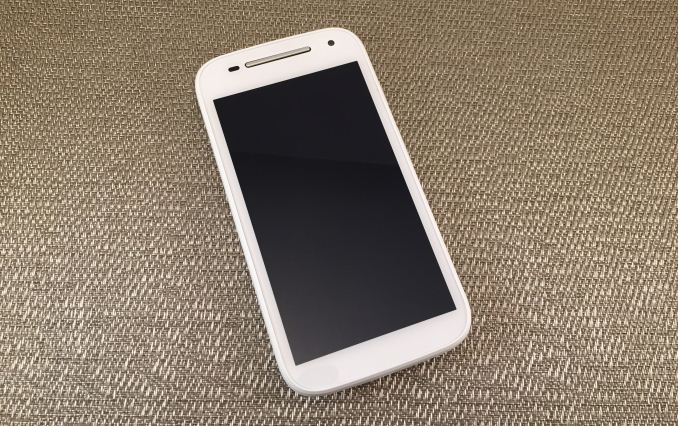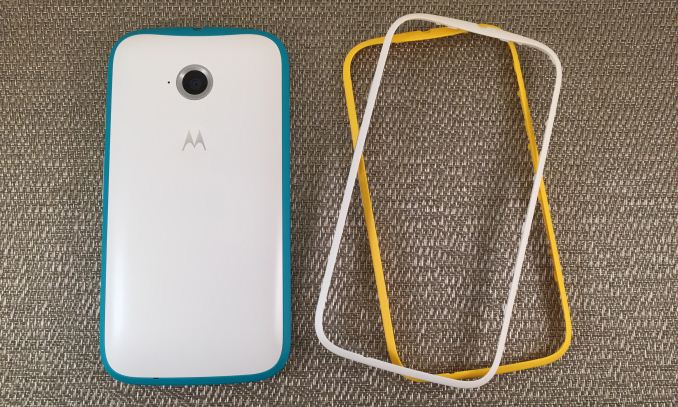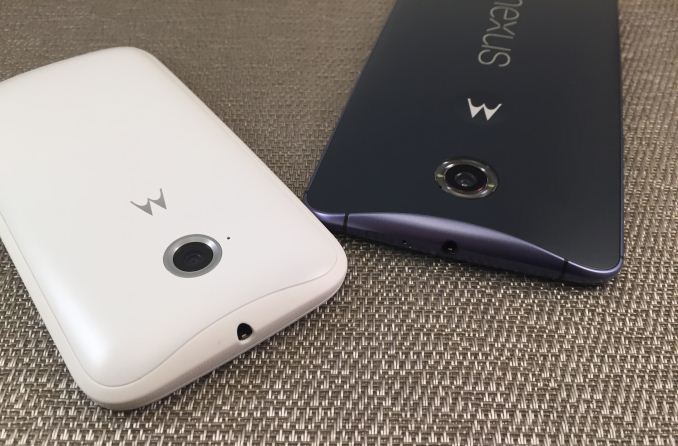The Moto E (2015) Review
by Brandon Chester on April 21, 2015 8:00 AM EST- Posted in
- Smartphones
- Motorola
- Mobile
- Moto E (2015)

During the past couple of years we've seen a dramatic shift in Motorola's strategy for competing in the smartphone market. As one of the earliest producers of Android devices, the company needed to let go of ideas and strategies from years that had since past. Producing exclusive devices for carriers like Verizon was no longer going to work with the iPhone finally freed from exclusivity on AT&T, and Motorola's hardware and software design had begun to show a great deal of age.
That brings us to today, at a point where Motorola has more or less found their new approach to making smartphones. It's a very simple and understandable approach. Consistency across the design of the hardware, consistency across the design of the software, and a yearly line of phones that can easily be divided into budget, mid-range, and flagship categories based on a single letter in their name. This review takes a look at the newest version of Motorola's budget device, the 2015 Moto E. Unfortunately, this year adds a bit of complexity to the simplicity of Motorola's smartphone line. Before getting into that, I've put the general specifications of the new Moto E below, with the original 2014 model as a point of comparison.
| Motorola Moto E (2015) (LTE model XT1527) |
Motorola Moto E (2015) (3G models) |
Motorola Moto E (2014) | |
| SoC | Qualcomm Snapdragon 410 (MSM8916) 4x Cortex A53 @ 1.2GHz Adreno 306 at 400MHz |
Qualcomm Snapdragon 200 (MSM8x10) 4x Cortex A7 @ 1.2GHz Adreno 302 at 400MHz |
Qualcomm Snapdragon 200 (MSM8x10) 2x Cortex A7 @ 1.2GHz Adreno 302 at 400MHz |
| RAM | 1 GB LPDDR3 | 1GB LPDDR2 | |
| NAND | 8GB NAND + microSD | 4GB NAND + microSD | |
| Display | 4.5” 960x540 IPS LCD | 4.3" 960x540 IPS LCD | |
| Network | 2G / 3G / 4G LTE (Qualcomm MDM9x25 UE Category 4 LTE) | 2G / 3G HSPA+ (MDM8x10) | 2G / 3G HSPA+ (MDM8x10) |
| Dimensions | 129.9 x 66.8 x 12.3mm 145g |
124.38 x 64.8 x 12.3mm 142g |
|
| Camera | 5MP (2592 х 1944) Rear Facing w/Auto Focus, F/2.2 aperture VGA (640x480) Front Facing |
5MP (2592 х 1944) Rear Facing w/Fixed Focus | |
| Battery | 2390 mAh (9.08Wh) | 1980 mAh (7.52Wh) | |
| OS | Android 5.0 | Android 4.4.2 | |
| Connectivity | 802.11 b/g/n + BT 4.0, USB2.0, GPS/GNSS | ||
| SIM Size | Micro-SIM | ||
On the cellular side, we have two HSPA models and 1 LTE model of the Moto E. There is an LTE version with UMTS bands targeted at the US market, a 3G-only version for the US market, and a global 3G version. The difference between the US and global 3G bands is the inclusion of the 1700MHz band for T-Mobile support on the US version, and the 900/2100MHz bands on the global version.
Design
Over the past couple of years, Motorola's hardware and software design has undergone some enormous changes. They shifted from producing heavily skinned and modified Android devices to using almost stock Google Android. Their industrial design similarly underwent significant changes, and a new style for their smartphones emerged with the original Moto X in 2013. The flat sides and edges of Motorola's old phones were replaced with continuous curves. This type of design is not only more ergonomic than Motorola's old devices, but also more unique and recognizable. It's very clear from the appearance of a Motorola phone that it is a Motorola phone, even without spotting the depressed logo on the back cover.
The Moto E is no exception to Motorola's industrial design. The back cover has a continuous curve that extends to all corners and meets with the phone's arched sides. The back of the phone has only a center-aligned 5MP camera and Motorola's standard indented logo. Unlike the original Moto E this back cover is no longer removable and customizable with different colors. Since the Moto E is a budget device, it also can't be customized with Motorola's Moto Maker. To add a level of personalization, Motorola has designed the phone so that the band around the edges is removable. Users can purchase a set of red, blue, and yellow bands for $20, and can swap them out with the default white or black bands as they please.
The band being removable creates a potential concern about the usability of the Moto E's buttons, as the part that you press down on is integrated into the bands themselves. During my time with the device I was actually surprised by how tactile the buttons felt and how little they wobbled considering that they were completely separated from the actual button mechanism. They definitely had more of a mushy feeling than the buttons on the Nexus 6, but they were still completely usable and actually better than I expected.
The removable bands also act as a great way to hide many of the ports on the device. Removing the band allows access to the Moto E's MicroSD slot and Micro-SIM port. The SIM slot is spring loaded, but it's so deep that anyone without very long nails will end up having to use a small object to press on the end of the SIM to remove it anyway.
The left side of the device has a tag which is attached internally and has FCC and regulatory information on it, as well as the device's IMEI.
I'm quite happy with the direction Motorola has gone in with regards to design. The basic design of a Motorola phone scales down to $150 devices and all the way up to $700 devices, and on all of them it's visually appealing as well as ergonomic. The material quality definitely takes a step down when you go for those budget devices, with the Moto E sporting a plastic outer band instead of the metal ones on the Moto X and Nexus 6. Despite that, the phone still feels well made and the matte plastic back actually feels just as nice as the one on the Nexus 6. If anything, Motorola might want to worry about their flagship devices not offering enough of an improvement over the very good build quality and materials of their budget offerings.













90 Comments
View All Comments
zepi - Tuesday, April 21, 2015 - link
How much does a 1A or 2A rated charger drop the charging times?I think it is a bit silly to compare chargers instead of phones.
arnoudw - Tuesday, April 21, 2015 - link
Exactly. I reviewed the phone as well (the European version) and the one that's for sale on this side of the ocean hasn't got a charger at all in the box. I just used another charger that I have to charge the phone and charge times were pretty normal: around 2,5 hours from zero to full.AT would maybe consider a disclaimer that chargers can differ per country or region and that can infuence the outcome of this particular test immensely. AT has got a worldwide audience and a lot of the potential buyers of this phone reading the review here might be from another part of the world. That's something for AT to consider, I guess.
TLDR; tested it as well, there was no charger included, charges normally with another charger.
sovking - Tuesday, April 21, 2015 - link
I agree. Charge time comparison should be done with the same charger or better with 2 or 3 chargers.Chargers for smarphone are universal, all devices connect to micro-usb chargers with 5V. At home we have more chargers for more smartphone and we do not matter which charger we are using.
So create a table showing a charging time when using 0.5A, 1A charger, 2A charger.
Some smartphone like Moto G 2014, limit input current, so it worth using until 1.5 A charger, more current is not used.
Ryan Smith - Tuesday, April 21, 2015 - link
To be clear here, the purpose is to test the charge time of the phone in its default configuration. It's not to compare just the chargers, but the entire package.hans_ober - Tuesday, April 21, 2015 - link
You've got a point; anyone who is buying this as their first Android (upgrading from an old Nokia), will most probably use the included charger and it was right to include the charge time using the 'package' the user would most probably use. However, since this is a case where the charger is to blame for the slow charging speeds, it would have been useful to include another result with another high powered charger, which would confirm that the phone IS capable of higher charging speeds if another charger is used and how much time could probably be saved by using a high powered charger.hans_ober - Wednesday, April 29, 2015 - link
Do you have a Quick charge 2.0 charger? The Motorola Turbo Charger? Just curious to see whether it works, because iirc QC 2.0 support was mentioned somewhere.victorson - Tuesday, April 21, 2015 - link
There is a mistake, the Moto E is not $109, it's actually $120 for the slow Snapdragon 200 version, and a not-so-cheap $150 for the Snadpragon 400 version. It's funny how the author can't think of competition when you have devices from Xiaomi and Meizu (among tens if not hundred others) that deliver better value for the money.close - Tuesday, April 21, 2015 - link
In EU the Moto E LTE is ~130E while the cheapest Xiaomi starts at ~170E. I wouldn't think twice.Brandon Chester - Tuesday, April 21, 2015 - link
The number of markets that you can purchase Xiaomi phones in is extremely small, you can count them on one hand. Also I apologize about the pricing error. There have been a few sales on it recently and for whatever reason I noted the price as $109. That being said, it does drop below Motorola's price very often. For example, it's currently available in India on Flipkart for $127 USD. India does happen to be an Xiaomi market and so I would definitely urge buyers there to check out their devices as well. But that's not an option for most buyers.victorson - Tuesday, April 21, 2015 - link
Thanks for the reply, Brandon! I agree that you can get the phone cheaper on sales and I wouldn't argue against the Moto E being an overall good value for the money, but it's also true that you can buy said Xiaomi phones (or many others for that matter, I don't want this to sound like an ad) from retailers like Pandawill.com, Coolicool.com, or others that ship internationally for free. And the user who said that Xiaomi starts at 170 euro, may want to pay a visit and see that prices on those sites start at around $120, not 170 euro.